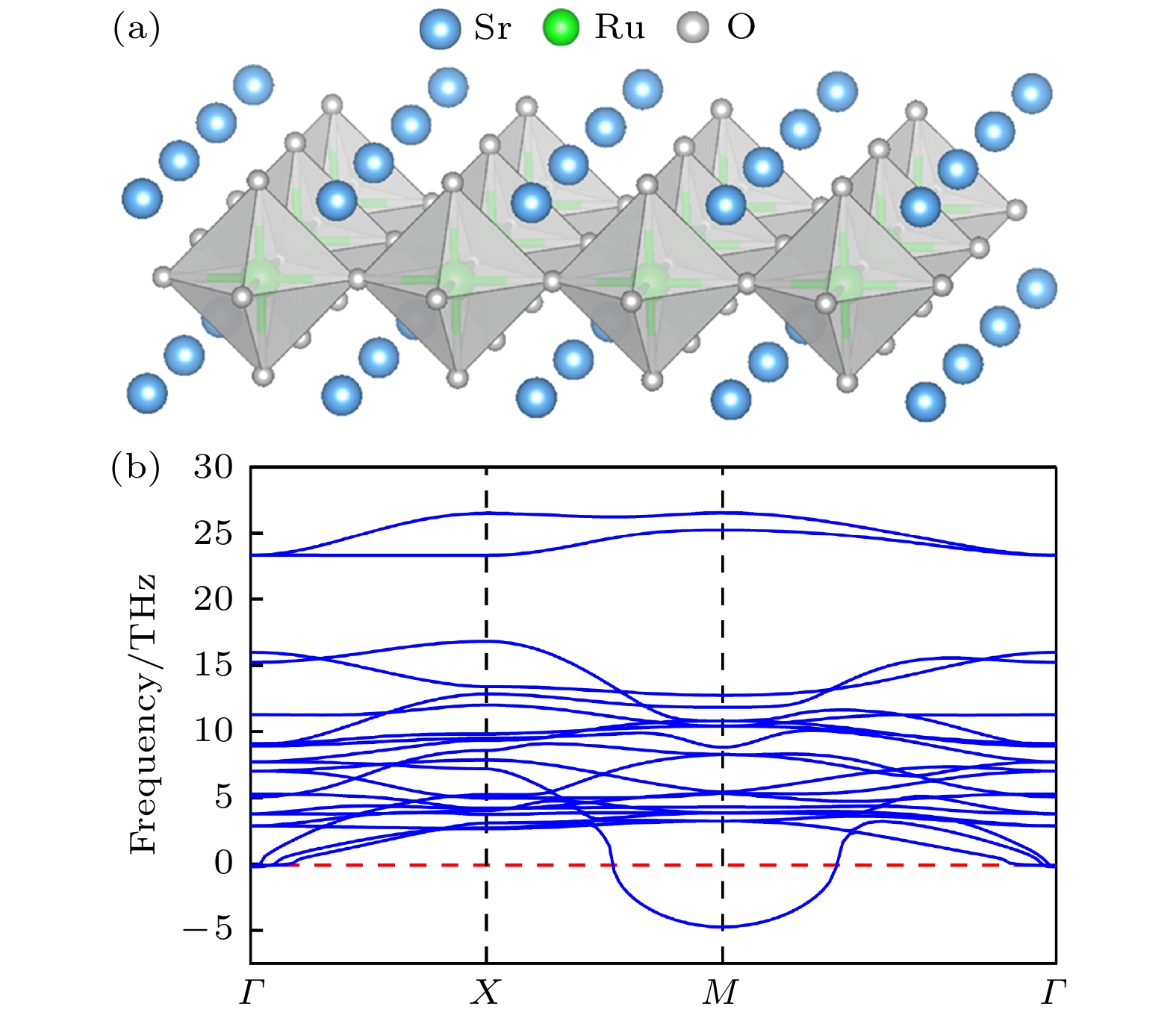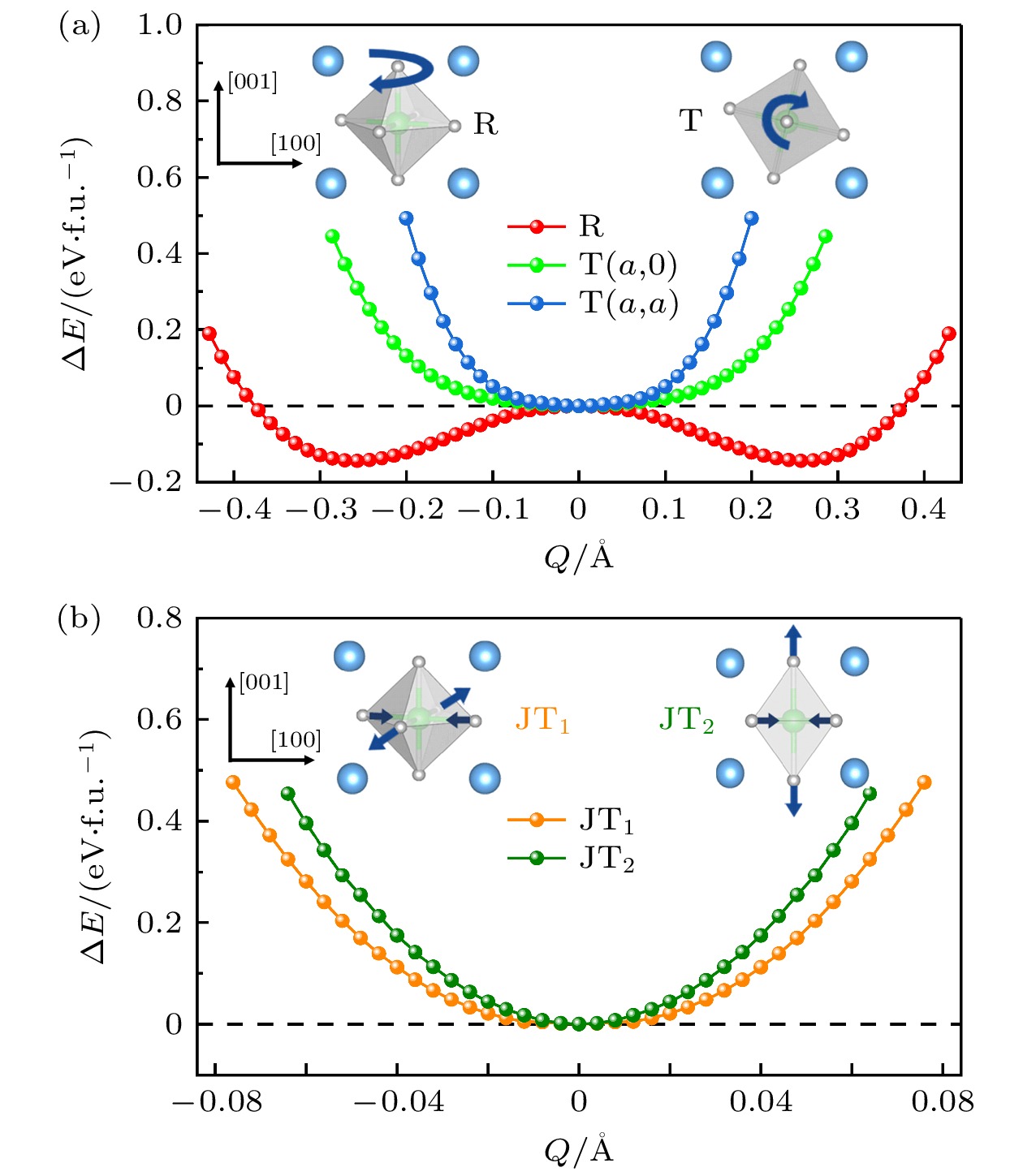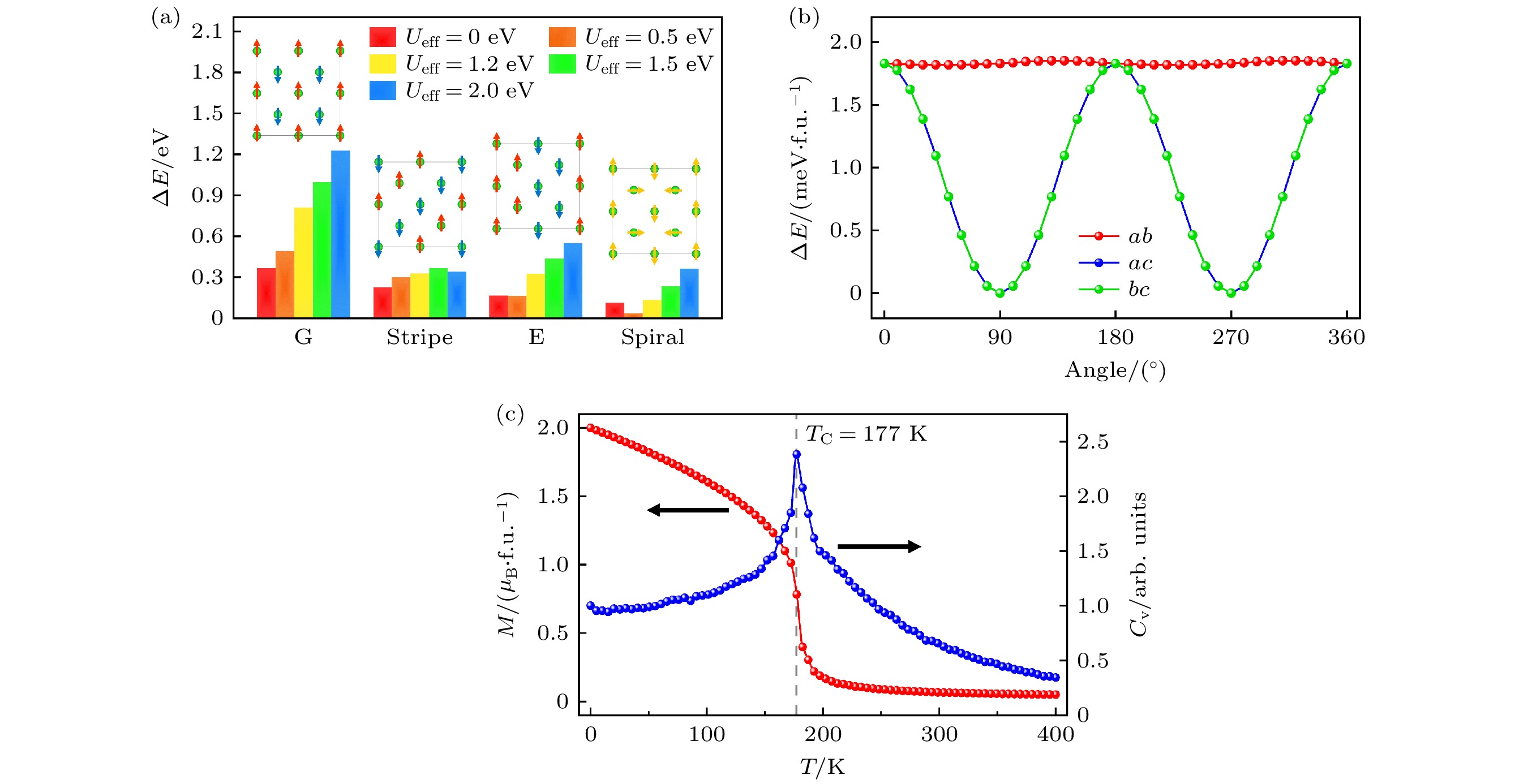-
At present, the research on two-dimensional (2D) ferromagnets is mainly concentrated on van der Waals materials, while the successful preparation of strain-free freestanding 2D perovskite films provides a great opportunity for designing 2D ferromagnets beyond van der Waals materials. Perovskite oxide SrRuO3, a typical perovskite itinerant ferromagnet, has broad application prospects in many fields. In this work, the lattice dynamics, ground-state structure, electronic and magnetic properties of its perovskite monolayer with formula Sr2RuO4, as well as the effect of external electric field, are studied by combining first-principles calculation, symmetry analysis and Monte Carlo simulation. The influence of the Hubbard parameter U is also revealed. The results indicate that the ground-state structure under all U values presents the structural phase (space group P4/mbm) generated by octahedral rotation distortion. Similar to the SrRuO3 bulk, Sr2RuO4 has a monolayer ground-state phase that exhibits ferromagnetism, which is independent of the U value and thus robust. Density functional theory calculation using Hubbard parameter U predicts the ground-state phase of the monolayer to be a ferromagnetic half metal with an out-of-plane easy-magnetization axis, while excluding that the U parameter predicts the ground-state phase to be a ferromagnetic metallic state. The ferromagnetism mainly originates from the strong ferromagnetic exchange interaction between the nearest neighbor spin pairs. The simulated Curie temperature of the Sr2RuO4 monolayer is 177 K, which is close to the value (150 K) of its bulk phase. The out-of-plane electric field does not change the ground-state structure nor ferromagnetism of the Sr2RuO4 monolayer, but can significantly modulate its electronic property and magnetic property. When an external electric field exceeding 0.3 V/Å is applied, the system undergoes a transition from a ferromagnetic half-metal state to a ferromagnetic metallic state. This work indicates the potential application of Sr2RuO4 monolayer in low-dimensional spintrnic devices, and provides a reference for developing perovskite-based 2D ferromagnets and realizing the control of 2D magnetism by electric field.
-
Keywords:
- two-dimensional ferromagnetism /
- perovskite /
- first principles
[1] Burch K S, Mandrus D, Park J G 2018 Nature 563 47
 Google Scholar
Google Scholar
[2] Gong C, Zhang X 2019 Science 363 706
 Google Scholar
Google Scholar
[3] 肖寒, 弭孟娟, 王以林 2021 70 127503
 Google Scholar
Google Scholar
Xiao H, Mi M J, Wang Y L 2021 Acta Phys. Sin. 70 127503
 Google Scholar
Google Scholar
[4] Gong C, Li L, Li Z, Ji H, Stern A, Xia Y, Cao T, Bao W, Wang C, Wang Y, Qiu Z Q, Cava R J, Louie S G, Xia J, Zhang X 2017 Nature 546 265
 Google Scholar
Google Scholar
[5] Huang B, Clark G, Navarro-Moratalla E, Klein D R, Cheng R, Seyler K L, Zhong D, Schmidgall E, McGuire M A, Cobden D H, Yao W, Xiao D, Jarillo-Herrero P, Xu X 2017 Nature 546 270
 Google Scholar
Google Scholar
[6] Song T C, Cai X H, Tu M W Y, Zhang X, Huang B, Wilson N P, Seyler K L, Zhu L, Taniguchi T, Watanabe K, McGuire M A, Cobden D H, Xiao D, Yao W, Xu X D 2018 Science 360 1214
 Google Scholar
Google Scholar
[7] Klein D R, MacNeill D, Lado J L, Soriano D, Navarro-Moratalla E, Watanabe K, Taniguchi T, Manni S, Canfield P, Fernández-Rossier J, Jarillo-Herrero P 2018 Science 360 1218
 Google Scholar
Google Scholar
[8] Kim H H, Yang B, Patel T, Sfigakis F, Li C, Tian S, Lei H, Tsen A W 2018 Nano Lett. 18 4885
 Google Scholar
Google Scholar
[9] Wang Z, Zhang T Y, Ding M, et al. 2018 Nat. Nanotechnol. 13 554
 Google Scholar
Google Scholar
[10] Jiang X, Liu Q X, Xing J P, Liu N S, Guo Y, Liu Z F, Zhao J J 2021 Appl. Phys. Rev. 8 031305
 Google Scholar
Google Scholar
[11] Dagotto E, Hotta T, Moreo A 2001 Phys. Rep. 344 1
 Google Scholar
Google Scholar
[12] Dagotto E 2005 Science 309 257
 Google Scholar
Google Scholar
[13] Eerenstein W, Mathur N D, Scott J F 2006 Nature 442 759
 Google Scholar
Google Scholar
[14] Hong S S, Yu J H, Lu D, Marshall A F, Hikita Y, Cui Y, Hwang H Y 2017 Sci. Adv. 3 eaao5173
 Google Scholar
Google Scholar
[15] Ji D X, Cai S H, Paudel T R, Sun H Y, Zhang C C, Han L, Wei Y F, Zang Y P, Gu M, Zhang Y, Gao W P, Huyan H X, Guo W, Wu D, Gu Z B, Tsymbal E Y, Wang P, Nie Y F, Pan X Q 2019 Nature 570 87
 Google Scholar
Google Scholar
[16] Lu J, Luo W, Feng J, Xiang H 2018 Nano Lett. 18 595
 Google Scholar
Google Scholar
[17] Zhang J T, Shen X F, Wang Y C, Ji C, Zhou Y, Wang J L, Huang F Z, Lu X M 2020 Phys. Rev. Lett. 125 017601
 Google Scholar
Google Scholar
[18] Zhang J T, Zhou Y, Wang F, Shen X F, Wang J L, Lu X M 2022 Phys. Rev. Lett. 129 117603
 Google Scholar
Google Scholar
[19] Zhou Y, Dong S, Shan C X, Ji K, Zhang J T 2022 Phys. Rev. B 105 075408
 Google Scholar
Google Scholar
[20] Shen X F, Wang F, Lu X M, Zhang J T 2023 Nano Lett. 23 735
 Google Scholar
Google Scholar
[21] Ji K, Wu Z, Shen X, Wang J, Zhang J 2023 Phys. Rev. B 107 134431
 Google Scholar
Google Scholar
[22] Gertjan K, Lior K, Wolter S, Guus R, Steven D J, Chang-Beom E, A B D H, R B M 2012 Rev. Mod. Phys. 84 253
 Google Scholar
Google Scholar
[23] Anwar M S, Lee S R, Ishiguro R, Sugimoto Y, Tano Y, Kang S J, Shin Y J, Yonezawa S, Manske D, Takayanagi H, Noh T W, Maeno Y 2016 Nat. Commun. 7 13220
 Google Scholar
Google Scholar
[24] Li W, Liao L, Deng C G, Lebudi C, Liu J C, Wang S X, Yi D, Wang L F, Li J F, Li Q 2024 Nano Lett. 24 5010
 Google Scholar
Google Scholar
[25] Ohnishi T, Takada K 2011 Appl. Phys. Express 4 025501
 Google Scholar
Google Scholar
[26] Wakabayashi Y K, Kaneta-Takada S, Krockenberger Y, Taniyasu Y, Yamamoto H 2021 ACS Appl. Electron. Mater. 3 2712
 Google Scholar
Google Scholar
[27] Kresse G, Hafner J 1993 Phys. Rev. B 47 558(R
 Google Scholar
Google Scholar
[28] Kresse G, Furthmüller J 1996 Phys. Rev. B 54 11169
 Google Scholar
Google Scholar
[29] Perdew J P, Ruzsinszky A, Csonka G I, Vydrov O A, Scuseria G E, Constantin L A, Zhou X, Burke K 2009 Phys. Rev. Lett. 102 039902
 Google Scholar
Google Scholar
[30] Şaşıoğlu E, Friedrich C, Blügel S 2011 Phys. Rev. B 83 121101
 Google Scholar
Google Scholar
[31] Dudarev S L, Botton G A, Savrasov S Y, Humphreys C J, Sutton A P 1998 Phys. Rev. B 57 1505
 Google Scholar
Google Scholar
[32] Kulik H J, Cococcioni M, Scherlis D A, Marzari N 2006 Phys. Rev. Lett. 97 103001
 Google Scholar
Google Scholar
[33] Blöchl P E 1994 Phys. Rev. B 50 17953
 Google Scholar
Google Scholar
[34] Campbell B J, Stokes H T, Tanner D E, Hatch D M 2006 J. Appl. Crystallogr. 39 607
 Google Scholar
Google Scholar
[35] Gonze X, Lee C 1997 Phys. Rev. B 55 10355
 Google Scholar
Google Scholar
[36] Togo A, Tanaka I 2015 Scr. Mater. 108 1
 Google Scholar
Google Scholar
[37] Marshall A F, Klein L, Dodge J S, Ahn C H, Reiner J W, Mieville L, Antagonazza L, Kapitulnik A, Geballe T H, Beasley M R 1999 J. Appl. Phys. 85 4131
 Google Scholar
Google Scholar
[38] Wang F, Zhou Y, Shen X F, Dong S, Zhang J T 2023 Phys. Rev. Appl. 20 064011
 Google Scholar
Google Scholar
-
图 2 Sr2RuO4单层每种晶格畸变模式的能量随模式幅度的变化, 涉及(a) 旋转(R)和倾斜(T), 以及(b) JT1和JT2扭曲模式. 插图为四种晶格扭曲模式的示意图, 其中弯曲的箭头代表八面体转动方向, 而直箭头表示阴离子位移方向
Figure 2. Energy variation of each distortion mode with the mode amplitude for the Sr2RuO4 monolayer, involves (a) rotation (R) and tilt (T), and (b) JT1 and JT2 modes. The illustration shows four lattice distortion modes, where the curved arrows represent the direction of octahedral rotation and the straight arrows indicate the direction of anion displacement
图 4 Sr2RuO4单层基态相在不同U值下的上自旋和下自旋投影能带结构 (a) $ U_{{\mathrm{eff}}} = 1.2 $ eV; (b) $ U_{{\mathrm{eff}}} = 2 $ eV; (c) $ U_{{\mathrm{eff}}} = 0 $ eV
Figure 4. Projected up and down spin band structures of the ground-state phase of Sr2RuO4 monolayer at different U values: (a) $ U_{{\mathrm{eff}}} = 1.2 $ eV; (b) $ U_{{\mathrm{eff}}} = 2 $ eV; (c) $ U_{{\mathrm{eff}}} = 0 $ eV.
图 5 (a) 不同反铁磁序的示意图和相对能量(相对于铁磁相), 以及$ U_{{\mathrm{eff}}} = 1.2 $ eV 时计算的(b)不同自旋面的磁各向异性能量曲线和 (c) 蒙特卡罗模拟的磁化和比热曲线
Figure 5. (a) Schematic of different antiferromagnetic orders and their relative energy (to ferromagnetic order) for the ground-state phase. (b) Energy curves of magnetic anisotropy for different spin planes, and (c) magnetization and specific heat curves in Monte Carlo simulation calculated at $ U_{{\mathrm{eff}}} = 1.2 $ eV.
表 1 Sr2RuO4单层不同晶格畸变模式及其各种组合所产生的结构相的对称性和不同U值下的相对能量, 其中基态相的能量被设置为0. 符号“—”表示对应的结构相不稳定, 即经过结构优化后转变为其他结构相
Table 1. Symmetry and the relative energy at different U values of structural phases resulting from different distortion modes and their various combinations for the Sr2RuO4 monolayer. Energy of the ground-state phase is set to 0. The symbol “—” represents that the corresponding structural phase is unstable, that is, it is transformed into another structural phases after structural optimization.
Distortion modes Space group $ \Delta E $/(meV·f.u.–1) $ U_{{\mathrm{eff}}} = 0 $ $ U_{{\mathrm{eff}}} = 0.5 $ $ U_{{\mathrm{eff}}} = 1.2 $ $ U_{{\mathrm{eff}}} = 1.5 $ $ U_{{\mathrm{eff}}} = 2 $ $ {\mathrm{Para}} $ $ P4/mmm $ 154 172 225 227 214 ${\mathrm{ R}}(M_2^+) $ $ P4/mbm $ 0 0 0 0 0 $ {\mathrm{T}}(a, 0)(M_5^+) $ $ Pmna $ — — 228 225 214 $ {\mathrm{T}}(a, a)(M_5^+) $ $ Cmma $ — — 227 224 212 $ {\mathrm{JT}}_1(M_3^+) $ $ P4/mbm $ — — — — — $ {\mathrm{JT}}_2(M_4^+) $ $ P4/mmm $ — — — — — $ {\mathrm{R}} \oplus {\mathrm{JT}}_1 $ $ Pbam $ — — — — — $ {\mathrm{R}} \oplus {\mathrm{JT_2}} $ $ P4/m $ — — — — — $ {\mathrm{R}} \oplus {\mathrm{T}}(a, 0) $ $ P2_1/c $ — — — — — $ {\mathrm{R}} \oplus {\mathrm{T}}(a, a) $ $ C2/m $ — — — — — $ {\mathrm{T}}(a, 0) \oplus {\mathrm{JT}}_1 $ $ P2_1/c $ — — — — — $ {\mathrm{T}}(a, 0) \oplus {\mathrm{JT_2}} $ $ P2/m $ — — — — — $ {\mathrm{T}}(a, a) \oplus{\mathrm{ JT}}_1 $ $ C2/m $ — — — — — $ {\mathrm{T}}(a, a) \oplus {\mathrm{JT}}_2 $ $ C2/m $ — — — — — $ {\mathrm{R}} \oplus {\mathrm{T}}(a, 0) \oplus {\mathrm{JT}}_1 $ $ P2_1/c $ — — — — — ${\mathrm{ R}} \oplus {\mathrm{T}}(a, 0) \oplus {\mathrm{JT}}_2 $ $ P\bar{1} $ — — — — — $ {\mathrm{R}} \oplus{\mathrm{ T}}(a, a) \oplus {\mathrm{JT}}_1 $ $ P\bar{1} $ — — — — — $ {\mathrm{R}} \oplus {\mathrm{T}}(a, a) \oplus {\mathrm{JT}}_2 $ $ P\bar{1} $ — — — — — 表 2 不同U值下计算的最近邻($ J_1 $)和次近邻($ J_2 $)磁交换作用参量, 磁各向异性常数(K), 磁矩(M)及居里温度($ T_{\mathrm{C }}$)
Table 2. Nearest neighbor ($ J_1 $) and next nearest neighbor ($ J_2 $) magnetic exchange interaction parameters, magnetic anisotropy constant (K), magnetic moment (M) and Curie temperature ($ T_{\mathrm{C}} $) calculated at different U values.
$ U_{{\mathrm{eff}}} $/eV $ J_1 $/meV $ J_2 $/meV K/meV M/$ \mu_{\mathrm{B}} $ $ T_{\mathrm{C}} $/K 0 11.48 –1.35 1.57 0.73 81 0.5 15.39 1.73 1.11 0.96 111 1.2 25.34 –2.41 1.83 1.43 177 1.5 31.18 –3.90 1.70 1.44 195 2 38.38 –8.53 1.81 1.47 202 -
[1] Burch K S, Mandrus D, Park J G 2018 Nature 563 47
 Google Scholar
Google Scholar
[2] Gong C, Zhang X 2019 Science 363 706
 Google Scholar
Google Scholar
[3] 肖寒, 弭孟娟, 王以林 2021 70 127503
 Google Scholar
Google Scholar
Xiao H, Mi M J, Wang Y L 2021 Acta Phys. Sin. 70 127503
 Google Scholar
Google Scholar
[4] Gong C, Li L, Li Z, Ji H, Stern A, Xia Y, Cao T, Bao W, Wang C, Wang Y, Qiu Z Q, Cava R J, Louie S G, Xia J, Zhang X 2017 Nature 546 265
 Google Scholar
Google Scholar
[5] Huang B, Clark G, Navarro-Moratalla E, Klein D R, Cheng R, Seyler K L, Zhong D, Schmidgall E, McGuire M A, Cobden D H, Yao W, Xiao D, Jarillo-Herrero P, Xu X 2017 Nature 546 270
 Google Scholar
Google Scholar
[6] Song T C, Cai X H, Tu M W Y, Zhang X, Huang B, Wilson N P, Seyler K L, Zhu L, Taniguchi T, Watanabe K, McGuire M A, Cobden D H, Xiao D, Yao W, Xu X D 2018 Science 360 1214
 Google Scholar
Google Scholar
[7] Klein D R, MacNeill D, Lado J L, Soriano D, Navarro-Moratalla E, Watanabe K, Taniguchi T, Manni S, Canfield P, Fernández-Rossier J, Jarillo-Herrero P 2018 Science 360 1218
 Google Scholar
Google Scholar
[8] Kim H H, Yang B, Patel T, Sfigakis F, Li C, Tian S, Lei H, Tsen A W 2018 Nano Lett. 18 4885
 Google Scholar
Google Scholar
[9] Wang Z, Zhang T Y, Ding M, et al. 2018 Nat. Nanotechnol. 13 554
 Google Scholar
Google Scholar
[10] Jiang X, Liu Q X, Xing J P, Liu N S, Guo Y, Liu Z F, Zhao J J 2021 Appl. Phys. Rev. 8 031305
 Google Scholar
Google Scholar
[11] Dagotto E, Hotta T, Moreo A 2001 Phys. Rep. 344 1
 Google Scholar
Google Scholar
[12] Dagotto E 2005 Science 309 257
 Google Scholar
Google Scholar
[13] Eerenstein W, Mathur N D, Scott J F 2006 Nature 442 759
 Google Scholar
Google Scholar
[14] Hong S S, Yu J H, Lu D, Marshall A F, Hikita Y, Cui Y, Hwang H Y 2017 Sci. Adv. 3 eaao5173
 Google Scholar
Google Scholar
[15] Ji D X, Cai S H, Paudel T R, Sun H Y, Zhang C C, Han L, Wei Y F, Zang Y P, Gu M, Zhang Y, Gao W P, Huyan H X, Guo W, Wu D, Gu Z B, Tsymbal E Y, Wang P, Nie Y F, Pan X Q 2019 Nature 570 87
 Google Scholar
Google Scholar
[16] Lu J, Luo W, Feng J, Xiang H 2018 Nano Lett. 18 595
 Google Scholar
Google Scholar
[17] Zhang J T, Shen X F, Wang Y C, Ji C, Zhou Y, Wang J L, Huang F Z, Lu X M 2020 Phys. Rev. Lett. 125 017601
 Google Scholar
Google Scholar
[18] Zhang J T, Zhou Y, Wang F, Shen X F, Wang J L, Lu X M 2022 Phys. Rev. Lett. 129 117603
 Google Scholar
Google Scholar
[19] Zhou Y, Dong S, Shan C X, Ji K, Zhang J T 2022 Phys. Rev. B 105 075408
 Google Scholar
Google Scholar
[20] Shen X F, Wang F, Lu X M, Zhang J T 2023 Nano Lett. 23 735
 Google Scholar
Google Scholar
[21] Ji K, Wu Z, Shen X, Wang J, Zhang J 2023 Phys. Rev. B 107 134431
 Google Scholar
Google Scholar
[22] Gertjan K, Lior K, Wolter S, Guus R, Steven D J, Chang-Beom E, A B D H, R B M 2012 Rev. Mod. Phys. 84 253
 Google Scholar
Google Scholar
[23] Anwar M S, Lee S R, Ishiguro R, Sugimoto Y, Tano Y, Kang S J, Shin Y J, Yonezawa S, Manske D, Takayanagi H, Noh T W, Maeno Y 2016 Nat. Commun. 7 13220
 Google Scholar
Google Scholar
[24] Li W, Liao L, Deng C G, Lebudi C, Liu J C, Wang S X, Yi D, Wang L F, Li J F, Li Q 2024 Nano Lett. 24 5010
 Google Scholar
Google Scholar
[25] Ohnishi T, Takada K 2011 Appl. Phys. Express 4 025501
 Google Scholar
Google Scholar
[26] Wakabayashi Y K, Kaneta-Takada S, Krockenberger Y, Taniyasu Y, Yamamoto H 2021 ACS Appl. Electron. Mater. 3 2712
 Google Scholar
Google Scholar
[27] Kresse G, Hafner J 1993 Phys. Rev. B 47 558(R
 Google Scholar
Google Scholar
[28] Kresse G, Furthmüller J 1996 Phys. Rev. B 54 11169
 Google Scholar
Google Scholar
[29] Perdew J P, Ruzsinszky A, Csonka G I, Vydrov O A, Scuseria G E, Constantin L A, Zhou X, Burke K 2009 Phys. Rev. Lett. 102 039902
 Google Scholar
Google Scholar
[30] Şaşıoğlu E, Friedrich C, Blügel S 2011 Phys. Rev. B 83 121101
 Google Scholar
Google Scholar
[31] Dudarev S L, Botton G A, Savrasov S Y, Humphreys C J, Sutton A P 1998 Phys. Rev. B 57 1505
 Google Scholar
Google Scholar
[32] Kulik H J, Cococcioni M, Scherlis D A, Marzari N 2006 Phys. Rev. Lett. 97 103001
 Google Scholar
Google Scholar
[33] Blöchl P E 1994 Phys. Rev. B 50 17953
 Google Scholar
Google Scholar
[34] Campbell B J, Stokes H T, Tanner D E, Hatch D M 2006 J. Appl. Crystallogr. 39 607
 Google Scholar
Google Scholar
[35] Gonze X, Lee C 1997 Phys. Rev. B 55 10355
 Google Scholar
Google Scholar
[36] Togo A, Tanaka I 2015 Scr. Mater. 108 1
 Google Scholar
Google Scholar
[37] Marshall A F, Klein L, Dodge J S, Ahn C H, Reiner J W, Mieville L, Antagonazza L, Kapitulnik A, Geballe T H, Beasley M R 1999 J. Appl. Phys. 85 4131
 Google Scholar
Google Scholar
[38] Wang F, Zhou Y, Shen X F, Dong S, Zhang J T 2023 Phys. Rev. Appl. 20 064011
 Google Scholar
Google Scholar
Catalog
Metrics
- Abstract views: 3500
- PDF Downloads: 100
- Cited By: 0















 DownLoad:
DownLoad:





